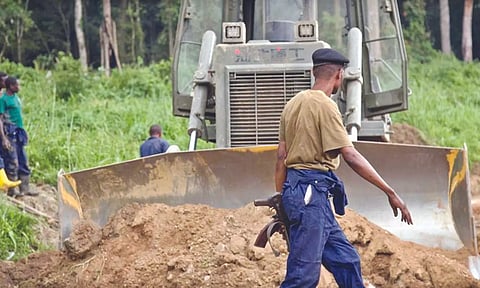

CENTRAL AFRICA: When Ugandan troops marched on the border of the Democratic Republic of Congo at the end of November 2021 for a joint military operation, the Congolese were astonished to see shovel excavators, bulldozers and asphalt machines delivered along with the expected war equipment.
People cheered and clapped. The sight of such machines is a rarity in Congo’s conflict-ridden eastern region, which is covered in muddy, potholed roads. These machines were set to work just a few kilometers across the border, where the only wooden bridge over the Semliki River was found to be full of holes, making it impassable for heavy vehicles.
So, under the protection of the soldiers, the road construction machines set about repairing it. Ugandan troops last crossed this border almost 25 years ago. Back then — in the midst of the 1998 to 2003 Second Congo War — they illegally invaded Congo to plunder valuable raw materials such as gold and diamonds.
When the Ugandans finally withdrew after five years, there was not much left of the roads and bridges. But now, the soldiers have come at Congo’s invitation. Their goal is to defeat the Ugandan Islamist Allied Democratic Forces (ADF) rebel group, which has been entrenched in the impassable border area since 2007.
This time, the Ugandans don’t want to destroy Congo’s infrastructure — they want to rebuild it. Repairing the roads is an essential part of the military operation,” a Ugandan army colonel told DW.
Security in eastern Congo’s conflict zones can only be achieved through the construction of better roads, explained Kristof Titeca, a professor in development studies at the University of Antwerp. “Roadblocks are an important source of income for these armed groups,” he told DW. These roadblocks are usually erected on dilapidated bridges or deep potholes, where trucks can only progress slowly.
On the one hand, better roads could be used to cut off the flow of money to the militias. At the same time, it will make it easier for the armed forces to intervene in difficult-to-reach areas “Many call [eastern Congo] a safe haven for armed groups, because there’s very little state presence and there’s very bad infrastructure. All of these makes it very difficult for state armed forces to intervene and take action.
So, the building of roads indeed would facilitate that,” said Titeca. Better roads in Congo are also beneficial for Uganda’s economy, said Susan Kataike, spokesperson for Uganda’s Transport Ministry.
Most of the trucks on Congo’s bumpy roads are from Uganda’s logistics companies, which often carry perishable goods such as plantains to Uganda. “It takes them a long time to reach [Uganda], so they make a lot of losses,” Kataike told DW.
“The stretch between Kasindi and Beni has been greatly improved and I am told that a journey that used to take people three hours is now only 40 minutes. That’s how beautiful this project is.” A lot is changing quickly, especially since Congo joined the East African Community in April 2022, which effectively doubled the territory of the bloc overnight.
Congo is an economic heavyweight in the region. On the one hand it’s a huge sales market, as it produces very little itself. But on the other hand, it is rich in raw materials such as rare earth elements, which have to pass through neighboring countries to reach the global market.
There are also a number of oil reserves lying dormant along the border with Uganda, which — if all goes to plan — will be pumped to the world market via the East African Crude Oil Pipeline, currently under construction.
With all of this combined, the East African Community states expect economic advancement.